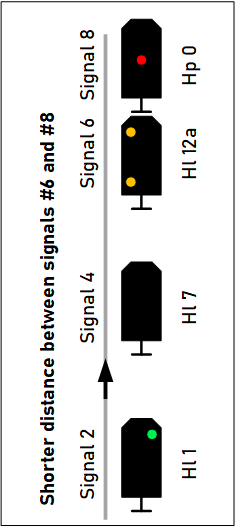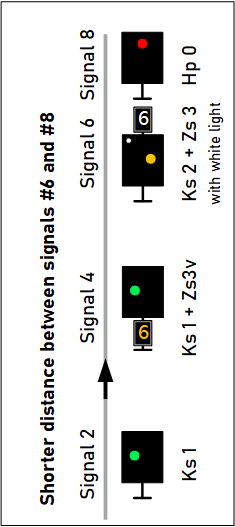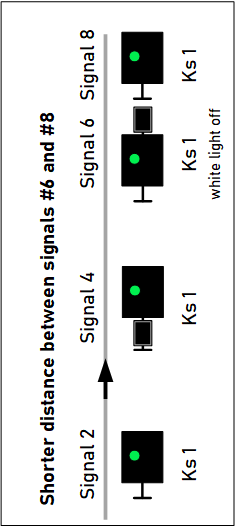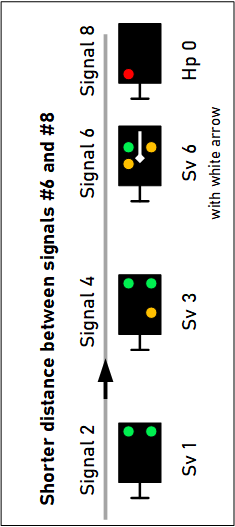Variable Speed Signalling
With the old Hp system, block signals were either at clear or
stop. With dense traffic, that could mean when a following train goes faster than a
preceding one, the following train will eventually see a distant signal at caution,
indicating the next block signal being at stop.
The train then has to brake and probably
stop for a few minutes. A more economic and comfortable would be to signal a lower speed
at the signal in rear, so that the following train will reach the signal in advance at
clear. However this practice has been in use on urban railway (S-Bahn) lines only. In
Berlin DR's Hl signals and the new Ks
signals are used, while Hamburg uses Sv signals.
In the example below, the distance between signals 6 and 8 (the one at stop) is shorter
than the braking distance. With both signalling systems, the preceding signal 4
induces a safe speed at signal 6. With the Ks system, the shorter distance is also
indicated by a white light, see below.
| Hl System |
 |
Signal 8 |
Stop. |
| Signal 6 |
Clear with 40 km/h, expect stop. |
| Signal 4 |
Clear with maximum speed, expect 40
or 60 km/h at next signal. |
| Signal 2 |
Clear. |
|
| Ks System |
 |
Signal 8 |
Stop. |
| Signal 6 |
Clear with 60 km/h, expect stop.
Since
the next signal is at shorter distance and requires (further) speed
reduction (in this case stop) the white light indicating the shorter
distance is on. |
| Signal 4 |
Clear with maximum speed, expect 60
km/h at next signal. |
| Signal 2 |
Clear, expect clear. |
|
Ks System
at clear |
 |
Signal 8 |
Clear, expect clear. |
| Signal 6 |
Clear,
expect clear.
Since that signal requires no
(further) speed reduction, the white light is off. |
| Signal 4 |
Clear,
expect clear. |
| Signal 2 |
Clear,
expect clear. |
|
| Sv System |
 |
Signal 8 |
Stop. |
| Signal 6 |
Clear with slow speed (40 km/h), expect stop. |
| Signal 4 |
Clear, expect slow speed (40 km/h). |
| Signal 2 |
Clear, expect clear. |
|




 home
home signalling
rules & practice
signalling
rules & practice email
email track map symbols
track map symbols signal usage & placement
signal usage & placement